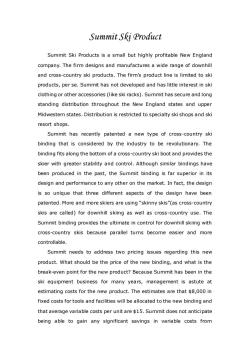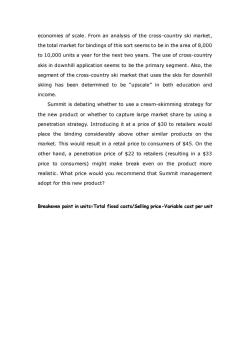《市场营销学》课程教学案例(双语)Summit Ski Produc

Summit Ski Product Summit Ski Products is a small but highly profitable New England company.The firm designs and manufactures a wide range of downhill and cross-country ski products.The firm's product line is limited to ski products,per se.Summit has not developed and has little interest in ski clothing or other accessories(like ski racks).Summit has secure and long standing distribution throughout the New England states and upper Midwestern states.Distribution is restricted to specialty ski shops and ski resort shops Summit has recently patented a new type of cross-country ski binding that is considered by the industry to be revolutionary.The binding fits along the bottom of a cross-country ski boot and provides the skier with greater stability and control.Although similar bindings have been produced in the past,the Summit binding is far superior in its design and performance to any other on the market.In fact,the design is so unique that three different aspects of the design have been patented.More and more skiers are using"skinny skis"(as cross-country skis are called)for downhill skiing as well as cross-country use.The Summit binding provides the ultimate in control for downhill skiing with cross-country skis because parallel turns become easier and more controllable. Summit needs to address two pricing issues regarding this new product.What should be the price of the new binding,and what is the break-even point for the new product?Because Summit has been in the ski equipment business for many years,management is astute at estimating costs for the new product.The estimates are that $8,000 in fixed costs for tools and facilities will be allocated to the new binding and that average variable costs per unit are $15.Summit does not anticipate being able to gain any significant savings in variable costs from
Summit Ski Product Summit Ski Products is a small but highly profitable New England company. The firm designs and manufactures a wide range of downhill and cross-country ski products. The firm’s product line is limited to ski products, per se. Summit has not developed and has little interest in ski clothing or other accessories (like ski racks). Summit has secure and long standing distribution throughout the New England states and upper Midwestern states. Distribution is restricted to specialty ski shops and ski resort shops. Summit has recently patented a new type of cross-country ski binding that is considered by the industry to be revolutionary. The binding fits along the bottom of a cross-country ski boot and provides the skier with greater stability and control. Although similar bindings have been produced in the past, the Summit binding is far superior in its design and performance to any other on the market. In fact, the design is so unique that three different aspects of the design have been patented. More and more skiers are using “skinny skis”(as cross-country skis are called) for downhill skiing as well as cross-country use. The Summit binding provides the ultimate in control for downhill skiing with cross-country skis because parallel turns become easier and more controllable. Summit needs to address two pricing issues regarding this new product. What should be the price of the new binding, and what is the break-even point for the new product? Because Summit has been in the ski equipment business for many years, management is astute at estimating costs for the new product. The estimates are that $8,000 in fixed costs for tools and facilities will be allocated to the new binding and that average variable costs per unit are $15. Summit does not anticipate being able to gain any significant savings in variable costs from

economies of scale.From an analysis of the cross-country ski market, the total market for bindings of this sort seems to be in the area of 8,000 to 10,000 units a year for the next two years.The use of cross-country skis in downhill application seems to be the primary segment.Also,the segment of the cross-country ski market that uses the skis for downhill skiing has been determined to be "upscale"in both education and income. Summit is debating whether to use a cream-skimming strategy for the new product or whether to capture large market share by using a penetration strategy.Introducing it at a price of $30 to retailers would place the binding considerably above other similar products on the market.This would result in a retail price to consumers of $45.On the other hand,a penetration price of $22 to retailers(resulting in a $33 price to consumers)might make break even on the product more realistic.What price would you recommend that Summit management adopt for this new product? Breakeven point in units=Total fixed costs/Selling price-Variable cost per unit
economies of scale. From an analysis of the cross-country ski market, the total market for bindings of this sort seems to be in the area of 8,000 to 10,000 units a year for the next two years. The use of cross-country skis in downhill application seems to be the primary segment. Also, the segment of the cross-country ski market that uses the skis for downhill skiing has been determined to be “upscale” in both education and income. Summit is debating whether to use a cream-skimming strategy for the new product or whether to capture large market share by using a penetration strategy. Introducing it at a price of $30 to retailers would place the binding considerably above other similar products on the market. This would result in a retail price to consumers of $45. On the other hand, a penetration price of $22 to retailers (resulting in a $33 price to consumers) might make break even on the product more realistic. What price would you recommend that Summit management adopt for this new product? Breakeven point in units=Total fixed costs/Selling price-Variable cost per unit
按次数下载不扣除下载券;
注册用户24小时内重复下载只扣除一次;
顺序:VIP每日次数-->可用次数-->下载券;
- 《市场营销学》课程教学案例(双语)Van Der Steen Candy Company.doc
- 《市场营销学》课程教学案例(双语)The Pepsi and Coca-Cola Challenge-A Cola with Breakfast.doc
- 《市场营销学》课程教学案例(中文)第1章案例 营销与营销管理-亚马逊名震全球之道.doc
- 《市场营销学》课程教学案例(中文)第2章案例 规划企业战略与市场营销管理-雅戈尔,选择没有对错.doc
- 《市场营销学》课程教学案例(中文)第4章案例 分析消费者市场与购买行为-小阿华的“精确营销”.doc
- 《市场营销学》课程教学案例(中文)第3章案例 市场营销环境-恒伟药业信息调研出效益.doc
- 《市场营销学》课程教学案例(中文)第5章案例 市场细分、决定目标市场与定位- “红高粱”的启示.doc
- 《市场营销学》课程教学案例(中文)第7章案例 价格决策-海信空调的价格策略.doc
- 《市场营销学》课程教学案例(中文)第6章案例 产品决策-广东太阳神的产品组合.doc
- 《市场营销学》课程教学案例(中文)第9章案例 促销策略-中国肥皂泡戏煞东瀛人.doc
- 《市场营销学》课程教学案例(中文)第8章案例 分销渠道策略-通用公司打造全球供应链.doc
- 《市场营销学》课程授课教案(双语)Chapter 1 Marketing.doc
- 《市场营销学》课程授课教案(双语)Chapter 3 Analyzing the Marketing Environment.doc
- 《市场营销学》课程授课教案(双语)Chapter 5 Consumer Markets and Consumer Buyer Behavior.doc
- 《市场营销学》课程授课教案(双语)Chapter 4 Managing Marketing Information to Gain Customer Insights.doc
- 《市场营销学》课程授课教案(双语)Chapter 2 Company and Marketing Strategy.doc
- 《市场营销学》课程授课教案(双语)Chapter 11 Communicating Customer Value.doc
- 《市场营销学》课程授课教案(双语)Chapter 8 Products, Services, and Brands.doc
- 《市场营销学》课程授课教案(双语)Chapter 7 Customer-Driven Marketing Strategy.doc
- 《市场营销学》课程授课教案(双语)Chapter 6 Business Markets and Business Buyer Behavior.doc
- 《市场营销学》课程教学案例(双语)Who will go to Saudi Arabia.doc
- 《市场营销学》课程教学案例(双语)Egle Steel Supply Company.doc
- 《市场营销学》课程教学案例(双语)Selling Whoppers In Japan.doc
- 内蒙古科技大学:《市场营销学》课程作业习题(分章)市场营销学练习及答案(共九章).doc
- 内蒙古科技大学:《市场营销学》课程作业习题(综合)综合习题九.doc
- 内蒙古科技大学:《市场营销学》课程作业习题(综合)综合习题九答案.doc
- 内蒙古科技大学:《市场营销学》课程作业习题(综合)综合习题十.doc
- 内蒙古科技大学:《市场营销学》课程作业习题(综合)综合习题十答案.doc
- 内蒙古科技大学:《市场营销学》课程作业习题(综合)综合习题八答案.doc
- 内蒙古科技大学:《市场营销学》课程作业习题(综合)综合习题七答案.doc
- 内蒙古科技大学:《市场营销学》课程作业习题(综合)综合习题八.doc
- 内蒙古科技大学:《市场营销学》课程作业习题(综合)综合习题七.doc
- 内蒙古科技大学:《市场营销学》课程作业习题(综合)综合习题六.doc
- 内蒙古科技大学:《市场营销学》课程作业习题(综合)综合习题六答案.doc
- 内蒙古科技大学:《市场营销学》课程作业习题(综合)综合习题五.doc
- 内蒙古科技大学:《市场营销学》课程作业习题(综合)综合习题五答案.doc
- 内蒙古科技大学:《市场营销学》课程作业习题(综合)综合习题四答案.doc
- 内蒙古科技大学:《市场营销学》课程作业习题(综合)综合习题四.doc
- 内蒙古科技大学:《市场营销学》课程作业习题(综合)综合习题三答案.doc
- 内蒙古科技大学:《市场营销学》课程作业习题(综合)综合习题三.doc
